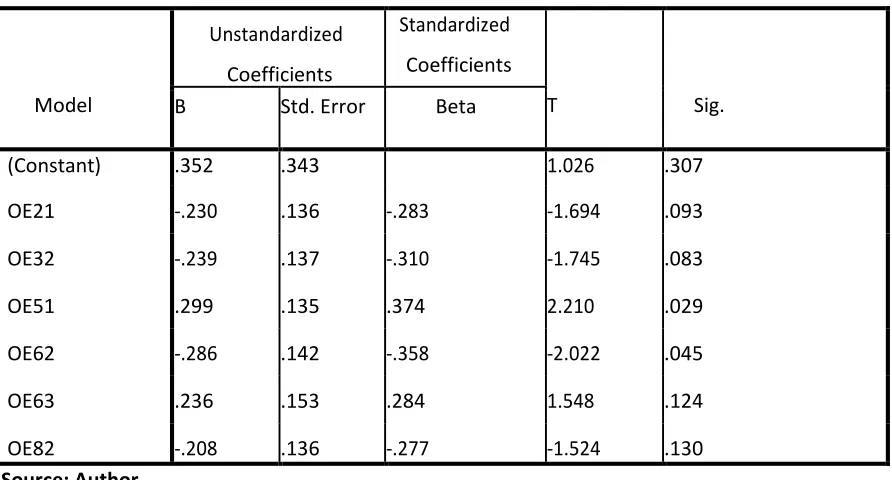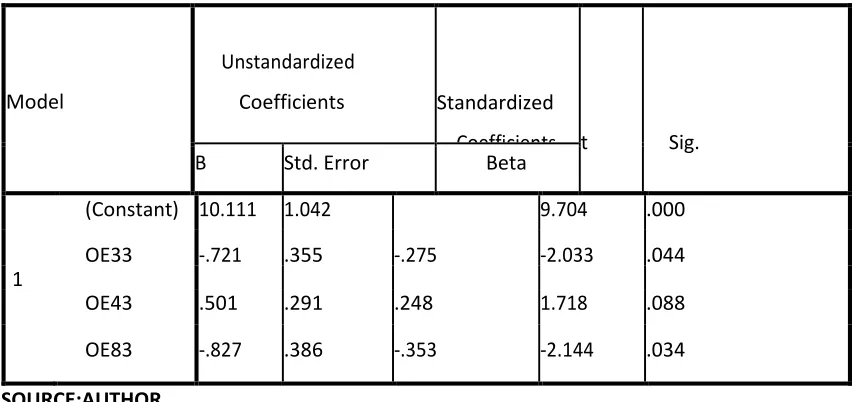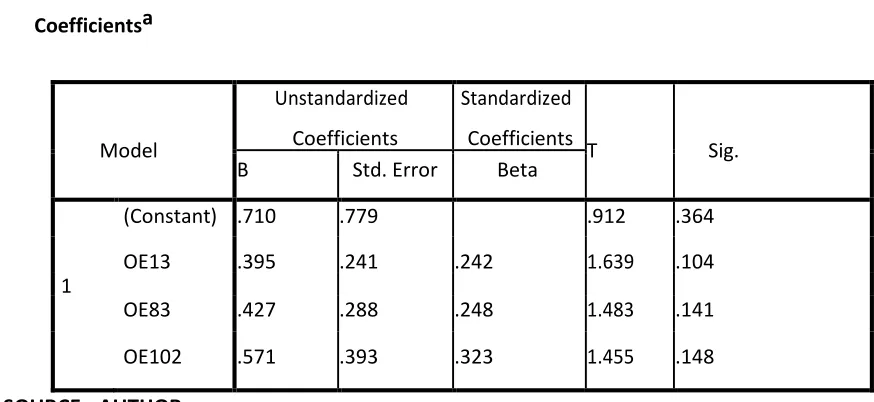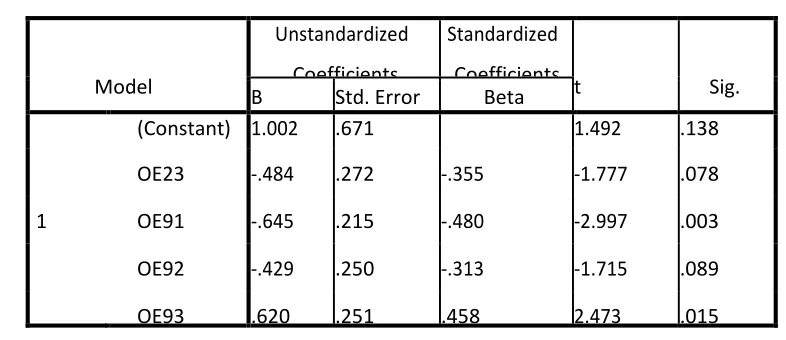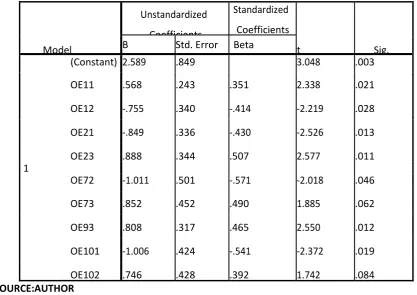INTERNATIONAL Journal in Management and Social Science
Volume 6 Issue 02, February 2018 ISSN: 2321-1784 Impact Factor: 6.178
Journal Homepage: http://ijmr.net.in, Email: irjmss@gmail.com Double-Blind Peer Reviewed Refereed Open Access International Journal
The Success Paradigm -Women Leaders & Organization Effectiveness.
Dr. Rohini G Shetty
Associate Professor.Bhavan’s M P Birla Institute of Management 43, Race Course Road, Bengaluru-560 001.Karnataka.
ABSTRACT
The challenges encountered by organizations of today are manifold. All organizations wish to
perform their best for sustainable economic growth. Globalization and intense competition
have made business growth and survival not only difficult but complex. Given this scenario,
Organizational Effectiveness becomes paramount to gain competitive advantage.
Leadership is a key resource and women leaders in IT are making waves in the Leadership
Landscape of today. Women have proved to be successful in IT firms given their ability to lead effectively, attain pre-set goals of the organization by optimum utilization of resources available at their disposal besides total involvement in organizations be it in the area of vision formulation ,
upholding values & culture or strategic leadership &people management.
Through empirical and theoretical analysis, the study attempts to examine the “Success Paradigm”
of Women Leaders in the IT sector and to know the imperatives for Organizational Effectiveness.
Success influences further success while failure is perceived to be a precursor for more to happen.
People, relationships, culture, communication style, organizational & family nuances along with
peer group influence may make a composite influence on Women Leaders in IT leading to their
success which needs an in-depth probe.
The study is descriptive - correlation and population of the research consists of select
Women Leaders from the IT sector of Bengaluru. Criteria such as Vision; Values; Morale; Culture;
People Management; Communication and Strategic Leadership are considered for Organizational
Effectiveness Assessment. The study aims to determine the relationship of Women Leaders
&Organizational effectiveness in IT sector. A demographic survey of Women Leaders is also a part
of the research conducted.
Key Words: Strategic Leadership; People Management; Organizational Performance Organization
INTERNATIONAL Journal in Management and Social Science
Volume 6 Issue 02, February 2018 ISSN: 2321-1784 Impact Factor: 6.178
Journal Homepage: http://ijmr.net.in, Email: irjmss@gmail.com Double-Blind Peer Reviewed Refereed Open Access International Journal
THE CONCEPT OF ORGANIZATIONAL EFFECTIVENESS
Organizational effectiveness or OE is the concept of how effective an organization can be in achieving all the desired outcomes it intends to produce. OE is the efficiency with which a firm is able to meet its pre-determined goals which literally means it has to produce the outcome by optimal utilization of the resources at its disposal. OE is achieved in organisations with minimum input and maximum output in terms of time, money, effort and other material resources. If a firm achieves OE then it surely will be on the path of progress and success. In business, this is referred to as maximizing wealth and ensuring economic growth.
Highly effective organizations exhibit strengths across areas such as leadership & decision making, values& culture, motivation & morale and excellent people management. Evaluating and improving OE is a key strategy to ensure growth and development of an organization and its leaders. Understanding the level of OE of a firm becomes important as it serves as a check list to identify company's strengths and weaknesses and highlight areas of ineffectiveness calling for improvements. OE measures generally provide the big-picture of the overall performance of a firm on the basis of a wide range of dimensions.
THE MEASURES OF ORGANIZATIONAL EFFECTIVENESS
INTERNATIONAL Journal in Management and Social Science
Volume 6 Issue 02, February 2018 ISSN: 2321-1784 Impact Factor: 6.178
Journal Homepage: http://ijmr.net.in, Email: irjmss@gmail.com Double-Blind Peer Reviewed Refereed Open Access International Journal
ORGANIZATION EFFECTIVENESS AND LEADERSHIP
Leadership is not about One-type-fits-all. It is highly debated and elicits a wide spectrum of opinions that range from describing personality attributes, position characteristics and even individual behaviors. Competent leaders exhibit a strong efficacy with influence on the confidence of its organizational members which is reflected in the endurance and prosperity of the organization. In business a leader supposedly influences the level of Organizational Effectiveness. Leaders must have the ability to formulate a clear vision, build teams, ensure team work and certainly stay put through thick and thin to help organizations come out as absolute winners.
James G. Bohn, in his paper entitled - The Relationship of Perceived Leadership Behaviors to Organization Efficacy, published in The Journal of Leadership and Organizational Studies (2002, Vol. 9, No. 1) conclusively indicates that leadership or the way leaders behave has a direct relationship to overall perceptions of organizational effectiveness and how organizations will perform. According to Bohn, “This is significant for leaders to understand, since they may be unaware of how their behaviors impact employees.” Employees place faith and trust in their leader’s capabilities, expecting the leader to provide a compelling vision of where the organization is heading; consistency in pursuing and achieving goals; clear and concise communication; team building and orchestration besides a track record of excellent performance.
RESEARCH METHODOLOGY
RESEARCH GAP - The survey of literature suggests that there are studies associated with the assessment of OE of Leaders and studies on Women Leadership as well, but there are no studies of composite nature establishing relationship between Demographics and OE of Women Leaders and the impact of OE on the success of Women Leaders in the IT sector of Bengaluru. The present study aims to fill up this gap.
INTERNATIONAL Journal in Management and Social Science
Volume 6 Issue 02, February 2018 ISSN: 2321-1784 Impact Factor: 6.178
Journal Homepage: http://ijmr.net.in, Email: irjmss@gmail.com Double-Blind Peer Reviewed Refereed Open Access International Journal
OBJECTIVES OF THE STUDY – The focus is on the triple aspects of Women Leaders in IT sector of Bengaluru.
To tap the changing scenario in Demographics of Women Leaders in IT sector. To examine the ten important of OE domains of Women Leaders in IT sector. To assess the impact of the ten OE domains on the success of Women Leaders in IT.
HYPOTHESES - The hypotheses floated for the research study are –
Demographics are significantly related to the OE of Women Leaders in IT.
Women Leaders significantly contribute to the OE of the organizations they lead. OE significantly impacts the success of Women Leaders in IT.
OPERATIONAL DEFINITIONS FOR THE STUDY - The research dictates the need for operational definitions for the respondent group and characteristics of interest. The definitions could be -
RESPONDENT GROUP - Educated Women Leaders with Technical and Management background with experience of not less three years , currently employed in IT firms of Bengaluru and empowered in decision making positions in areas such as technology, management, strategies and all the functional areas.
ORGANIZATIONAL EFFECTIVENESS – A concept of how effective an organization is in achieving the outcomes, the organization intends to produce with resources available at their disposal.
SELECTION OF SECTOR -The IT sector in India has grown exponentially and also witnessed a high proportion of successful Women Leaders. Both in terms of work & family responsibilities, women have proved to be competent leading to overall success. The selection of IT sector is justified on the grounds of making critical assessment of Women Leaders and Organizational Effectiveness.
INTERNATIONAL Journal in Management and Social Science
Volume 6 Issue 02, February 2018 ISSN: 2321-1784 Impact Factor: 6.178
Journal Homepage: http://ijmr.net.in, Email: irjmss@gmail.com Double-Blind Peer Reviewed Refereed Open Access International Journal
eight countries to worldwide.
UNIVERSE OF THE STUDY - Women Leaders working in IT & ITeS industry in Bengaluru which has three thousand plus IT firms with almost 40% women employees constituting its workforce. It stands justified on the grounds of huge employment generation for women in particular along with support provided by the government.
SAMPLE DESIGN - The estimated population size of Women Leaders in Bengaluru city was pegged at 1, 36,907. The Sample size was determined on the basis of gender ratio estimated for Bengaluru by census reports. The determined sample size “n” at 5% error with standard deviation fixed at .080 came to n=136. The no. of women leaders covered was 10% of the total population with the final sample size constituting 156 women leaders.
DESIGN OF THE STUDY – This was to facilitate data collection. All data was collected and collated to fulfill the needs of the study. The composite instrument consisted of two parts –
(DP -10) Demographics – 10 Statements in all including the option of individual name and the IT firm employed in.
(OE-10) 10 domains with 3 statements for each domain, a total of 30 statements in all. The OE instrument was developed by the author based on its suitability and appropriateness for the study.
*NOTE - {OE instruments already in existence were referred to and served as a base for the OE instrument developed}.
DATA TREATMENT AND ANALYSIS - The data collected was documented and tested for outliers, checked for wrong coding, inappropriate extremity in values and rechecked before statistical analyses. The first tool was on testing reliability of data set, Cronbach’s alpha was computed for standardized statements in the OE statements. Factor Analysis Correlation Analysis and Regression Analysis were done to arrive at the results.
RELATIONSHIP OF DEMOGRAPHICS WITH ORGANIZATIONAL EFFECTIVENESS OF WOMEN LEADERS
INTERNATIONAL Journal in Management and Social Science
Volume 6 Issue 02, February 2018 ISSN: 2321-1784 Impact Factor: 6.178
Journal Homepage: http://ijmr.net.in, Email: irjmss@gmail.com Double-Blind Peer Reviewed Refereed Open Access International Journal
Each one of these have three sub-dimensions. There are 30 statements in all of Organizational Effectiveness that are assessed to examine their influence on the demographic variables of Women Leaders, independently.
ASSESSMENT OF ORGANIZATIONAL EFFECTIVENESS- OE constitutes the efficiency with which an organization is able to meet its objectives to produce a desired effect or an organization that is productive without any waste. OE is about each employee doing everything well. In simple words, it is the capacity of an organization to produce desired results with a minimum expenditure of energy, time, money, and human and material resources. The desired effect will depend on the goals of the organization.
TABLE 1: OE WITH AGE OF RESPONDENT
Coefficientsa SOURCE: AUTHOR
There is no relationship evidence between age and organizational effectiveness i.e., as age progresses with women executives one cannot expect OE to improve. Although many aspects improve with age and experience, age is a subtle factor not associated with OE. There are however specific variables impacted by age. The mother makes an impact and influences indirectly on OE. Interestingly it is statistically significant with α = 0.119 (t = 1.569).There is strong influence in the formative years which will make a person responsive at the workplace.
Model Unstandardized
Coefficients
Standardized Coefficients
T Sig.
B Std. Error Beta
(Constant) .416 .572 .728 .468
1
INTERNATIONAL Journal in Management and Social Science
Volume 6 Issue 02, February 2018 ISSN: 2321-1784 Impact Factor: 6.178
Journal Homepage: http://ijmr.net.in, Email: irjmss@gmail.com Double-Blind Peer Reviewed Refereed Open Access International Journal
TABLE 2: OE WITH NOTIONAL IQ OF THE RESPONDENT
Coefficientsa
Model
Unstandardized Coefficients
Standardized Coefficients
T Sig.
B Std. Error Beta
(Constant) .352 .343 1.026 .307
OE21 -.230 .136 -.283 -1.694 .093
OE32 -.239 .137 -.310 -1.745 .083
OE51 .299 .135 .374 2.210 .029
OE62 -.286 .142 -.358 -2.022 .045
OE63 .236 .153 .284 1.548 .124
OE82 -.208 .136 -.277 -1.524 .130
Source: Author
A statistical relationship exists between Notional IQ and OE. The multiple correlation coefficients at 0.544 with R2 value of 0.296. The adjusted value of R2 is derived at 0.127 for the equation. The relationship is statistically strong at F = 1.755 and 0.017.The observations are however, auto correlated on the lower side. The effectiveness of relationship with reference to IQ is in articulation of values of the organization.(t=-1.694,α=0.093). A woman executive believes that she is responsible for building a culture of performance. The ability to think right and making it happenis pronounced in women executives (t = -1.745,
α=0.083).Regularity in communication will influence the organization to perform better (t = 2.210, α = 0.029).The ability to develop working relationships is in creating the spirit of working together. This can happen only by evolving a collaborative environment (t = -2.022, α = 0.045 and t = 1.548, α = 0.124).
INTERNATIONAL Journal in Management and Social Science
Volume 6 Issue 02, February 2018 ISSN: 2321-1784 Impact Factor: 6.178
Journal Homepage: http://ijmr.net.in, Email: irjmss@gmail.com Double-Blind Peer Reviewed Refereed Open Access International Journal
Table 3: OE with Experience in Years of the Respondent
Coefficientsa
SOURCE:AUTHOR
Experience serves as the best teacher, more the experience an executive acquires, more will be her effectiveness. All OE variables manifest by experience. The multiple regression model is strong with multiple R at 0.562 and an R2 = 0.315.The Adjusted value of R2 is 0.151.The entire model has an F value of 1.919 and α = 0.007. The observations are slightly auto correlated with D -W statistic at 1.831. Sharing the methods of performance with employees will lead to better performance (t=-2.033,α=0.044). This openness increases the morale of employees in several ways. Employees prefer to work in the same organization because of positive environment (t=1.718,α=0.088).Organizational goal directed behavior coupled with motivation helps in achieving targets (t = -2.144, α = 0.034).Thus, the variables which are acquired through experience are in articulation of values, regular communication, building up of a collaborative environment and organizational goal directed behavior.
TABLE 4: OE WITH TOTAL ANNUAL HOUSEHOLD INCOME OF THE RESPONDENT Model
Unstandardized
Coefficients Standardized
Coefficients t Sig.
B Std. Error Beta
(Constant) 10.111 1.042 9.704 .000
OE33 -.721 .355 -.275 -2.033 .044
1
OE43 .501 .291 .248 1.718 .088
INTERNATIONAL Journal in Management and Social Science
Volume 6 Issue 02, February 2018 ISSN: 2321-1784 Impact Factor: 6.178
Journal Homepage: http://ijmr.net.in, Email: irjmss@gmail.com Double-Blind Peer Reviewed Refereed Open Access International Journal
Coefficientsa
Model
Unstandardized Coefficients
Standardized
Coefficients T Sig.
B Std. Error Beta
(Constant) .710 .779 .912 .364
OE13 .395 .241 .242 1.639 .104
1
OE83 .427 .288 .248 1.483 .141
OE102 .571 .393 .323 1.455 .148
SOURCE - AUTHOR
Money matters but not all the time. The realization of vision can happen by grooming new leaders within an organizational setting (t = 1.639, α = 0.104). This is to be supplemented by motivational exercises to facilitate goal directed behaviors (t=1.483,α=0.141). Leadership involvement with employees will make things move forward and happen. The effectiveness of an organization with reference to income lies in grooming new leadership, encouraging goal directed behaviors with leader involvement. The multiple value of R is 0.540 and the value of R2 is 0.291. The Adjusted value of R2 is 0.121.The entire model of ANOVA is statistically significant and acceptable with an F value of 1.711 and α=0.022. Since money makes an influence on behavior of employees it will help groom leaders for future of the organization (t=1.639, α=0.104) .Better income and enhancing motivation will lead to better performance. Money alone will not lead to success but leadership helps one to be effective in the organization thereby leading to success. It is observed that employees expect their leaders to be available always and this is across hierarchy (t=1.455, α=0.148).
INTERNATIONAL Journal in Management and Social Science
Volume 6 Issue 02, February 2018 ISSN: 2321-1784 Impact Factor: 6.178
Journal Homepage: http://ijmr.net.in, Email: irjmss@gmail.com Double-Blind Peer Reviewed Refereed Open Access International Journal
Model
Unstandardized Coefficients
Standardized Coefficients
t Sig.
B Std. Error Beta
(Constant) 1.002 .671 1.492 .138
OE23 -.484 .272 -.355 -1.777 .078
1 OE91 -.645 .215 -.480 -2.997 .003
OE92 -.429 .250 -.313 -1.715 .089
OE93 .620 .251 .458 2.473 .015
SOURCE: AUTHOR
A reasonably strong correlation exists between the level of education of father and the woman executive i.e., daughter .The value of multiple correlation R = 0.495 with R2 value at 0.245. The adjusted value is 0.064 indicating that only few variables affect the relationship. The value of F at 1.355 is significant at α = 0.126. Interestingly, women executives inherit their values from father (t=-1.777, α=0.078). This factor helps in impacting people for performance tasks. The values that the organization setsisonthebasisofdemonstratedvaluesofthewomenexecutivesattheworkplace (t = -2.997, α = 0.003).Further demonstration of values will make the leader a “Peopleperson”. This will lead to recognizing people as assets(t=-1.715,α=0.089 and t = 2.473, α =0.015).
TABLE 6: OE WITH EDUCATION LEVEL OF THE MOTHER.
INTERNATIONAL Journal in Management and Social Science
Volume 6 Issue 02, February 2018 ISSN: 2321-1784 Impact Factor: 6.178
Journal Homepage: http://ijmr.net.in, Email: irjmss@gmail.com Double-Blind Peer Reviewed Refereed Open Access International Journal
Model
Unstandardized Coefficients
Standardized
Coefficients t Sig.
B Std. Error Beta
(Constant) 2.820 .701 4.022 .000
OE11 .417 .201 .317 2.078 .040
OE12 -.694 .281 -.469 -2.471 .015
OE21 -.802 .278 -.501 -2.890 .005
1
OE23 .775 .284 .546 2.725 .007
OE73 .656 .373 .465 1.757 .081
OE101 -.965 .350 -.640 -2.758 .007
OE103 .833 .328 .503 2.537 .012
SOURCE - AUTHOR
Parents in general help shape up work and leadership behavior amongst women executives .The education level of mother makes an impact but not as strong as that of the father of the woman executive. This is reflected with R at 0.492 and R2 at 0.242.The Adjusted value of R2 is α = 0.060.The F value for the entire model is 1.329 with α = 0.142. The observations are however not auto correlated
INTERNATIONAL Journal in Management and Social Science
Volume 6 Issue 02, February 2018 ISSN: 2321-1784 Impact Factor: 6.178
Journal Homepage: http://ijmr.net.in, Email: irjmss@gmail.com Double-Blind Peer Reviewed Refereed Open Access International Journal
TABLE 7: OE WITH EDUCATIONAL LEVEL OF FATHER-IN-LAW Coefficientsa
Model
Unstandardized Coefficients
Standardized Coefficients
t Sig.
B Std. Error Beta
(Constant) 2.589 .849 3.048 .003
OE11 .568 .243 .351 2.338 .021
OE12 -.755 .340 -.414 -2.219 .028
OE21 -.849 .336 -.430 -2.526 .013
OE23 .888 .344 .507 2.577 .011
1
OE72 -1.011 .501 -.571 -2.018 .046
OE73 .852 .452 .490 1.885 .062
OE93 .808 .317 .465 2.550 .012
OE101 -1.006 .424 -.541 -2.372 .019
OE102 .746 .428 .392 1.742 .084
SOURCE:AUTHOR
Father-in-law has a strong influence on the daughter-in-law. There is a high multiple correlation of R=0.518 with R2=0.269. The Adjusted R2 of 0.093 with all observations is not auto correlated. The model is strong enough with Fvalue1.529atα=0.56.Father-in-law in fluencies the woman executive on clarity of vision and facilitates achievement of goals of the organization (t=2.338,α=0.021and t=-2.219,α=0.028). Further, the values of an executive will get consolidated with the influence of father-in-law. The importance of values in bringing about harmony in relationships is strongly evident here (t=-2.526,α=0.013andt=2.577,α=0.011).Women leaders nurture family and in the same way they also nurture the organization they lead. Family promotes success and hence the individual stability (t = -2.018, α = 0.046 and t=1.885,α=0.062).The ability to transform an organization and to help change organizational environment comes from the strong influence of father-in-law ((t = - 2.550, α = 0.012). The way executives want to get engaged and involve people is strong from the manifestation of experiences at home(t=-2.372,α=0.019 and t = 1.742, α =0.084).
INTERNATIONAL Journal in Management and Social Science
Volume 6 Issue 02, February 2018 ISSN: 2321-1784 Impact Factor: 6.178
Journal Homepage: http://ijmr.net.in, Email: irjmss@gmail.com Double-Blind Peer Reviewed Refereed Open Access International Journal
Coefficientsa
Model
Unstandardized Coefficients
Standardized Coefficients
t Sig.
B Std. Error Beta
(Constant) 4.280 .982 4.360 .000
OE21 -.765 .389 -.358 -1.969 .051
1 OE52 .663 .432 .325 1.534 .128
OE72 -1.103 .579 -.576 -1.905 .059
OE73 1.252 .522 .665 2.397 .018
SOURCE: AUTHOR
Interestingly, in the Indian context, although strong multiple relationships exist between daughters-in-law and education level of mothers-in-law, the ANOVA model is not statistically significant. The inherited value of “A Special Dislike” for the mother-in-law could be one of the reasons for this complex relationship. Women executives articulate values (t=-1.969,α=.051)at their work place however they are open to inputs & ideas given by employees (t==1.534,α=0.128). Executives strongly believe in family orientation and consider it as the foundation for individual stability and success (t=-1.905;α=0.059;t=2.397,α=0.018).It is noted that the strength of the family values is mostly emulated from parents and father-in-law by the women executives.
CONCLUSIONS
INTERNATIONAL Journal in Management and Social Science
Volume 6 Issue 02, February 2018 ISSN: 2321-1784 Impact Factor: 6.178
Journal Homepage: http://ijmr.net.in, Email: irjmss@gmail.com Double-Blind Peer Reviewed Refereed Open Access International Journal
While, it is a difficult task to measure and express OE in a concrete formula, organisations could identify different dimensions for OE assessment based on suitability keeping in mind the specific goals and outcomes desired and achieved by the organization. The
Any OE assessment exercise helps in identifying both strengths and weaknesses. Strengths and effective areas could be highlighted and used to advantage whereas weaknesses and areas of ineffectiveness could be utilized to improved OE. This is highly beneficial as organizations could formulate an appropriate strategy and a road map for future changes and improvement which could spell progress and thus serve as as a great initiative to increase organizational effectiveness.
ANOVA Table Demographics and OE
Model Sum of
Squares
df Mean
Square
F Sig.
1 Age
Regression 22.488 30 .750 .972 .515b
Residual 96.352 125 .771
Total 118.840 155
2 Notional IQ
Regression 14.595 30 .486 1.755 .017b
Residual 34.655 125 .277
Total 49.250 155
3 Experience (Years)
Regression 147.240 30 4.908 1.919 . 007b
Residual 319.734 125 2.558
Total 466.974 155
4
Total Annual Household Income (Rupees.)
Regression 73.348 30 2.445 1.711 .0226b
Residual 178.575 125 1.429
Total 251.923 155
5
Educational Level of Father
Regression 43.187 30 1.440 1.355 .126b
Residual 132.788 125 1.062
Total 175.974 155
6
Educational Level of Mother
Regression 46.156 30 1.539 1.329 .142b
Residual 144.742 125 1.158
Total 190.897 155
7
Educational Level of Father In Law
Regression 77.964 30 2.599 1.529 .056b
Residual 212.395 125 1.699
Total 290.359 155
8
Educational Level of Mother In Law
Regression 56.154 30 1.872 .824 .725b
Residual 283.820 125 2.271
Total 339.974 155
INTERNATIONAL Journal in Management and Social Science
Volume 6 Issue 02, February 2018 ISSN: 2321-1784 Impact Factor: 6.178
Journal Homepage: http://ijmr.net.in, Email: irjmss@gmail.com Double-Blind Peer Reviewed Refereed Open Access International Journal
SELECT REFERENCES
A system resource approach to organizational effectiveness; Yuchtman, E., & Seashore, S.
E., (1987) American Sociological Review.
Assessing Organizational Effectiveness; Zammuto, R. F., (1982).State University of New
York Press, Albany, NY.
Developmental challenges and barriers: How senior executive women cope with
difficult situations in their careers - Dr. Katherine Copsinis Powel, University of
Massachusetts –Amherst
Effect of Leadership Styles on Organizational Effectiveness. Rukhmani, K., Ramesh, M.,
& Jayakrishnan, J ;European Journal of Social Sciences.Volume 15, Number 3 (2010)
Impact of Employees Motivation on Organizational Effectiveness Quratul-Ain
Manzoor ; European Journal of Business and Management ; Volume 3, No.3
Indian Women Leaders - Defining Leadership as they march ahead ; Article - Arva
Shikari , Senior Research Associate with Great Place to Work® Institute, India;
"Indian IT-BPO Industry". NASSCOM.
Journals.sagepub.com
Qualities of Women Leaders-The Unique Leadership Characteristics of Women; Article By
Linda Lowen.
What_is organisational_effectiveness ; www.researchgate.net
Women in Indian Information Technology (IT) sector: a Sociological Analysis by Asmita
Bhattacharyya; Dr. Bhola Nath
The glass hammer – Smart women in numbers – online community for women - Top
organisations preparing our future female leaders – By Jacqueline B.Lister ; 9/11/13
Using Employee Gainsharing Plans to improve Organizational Effectiveness.

